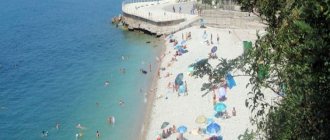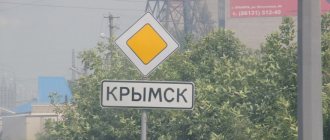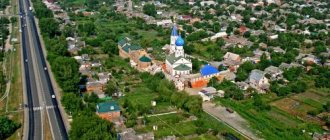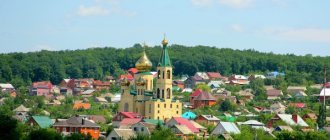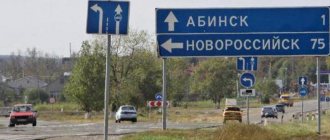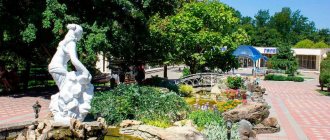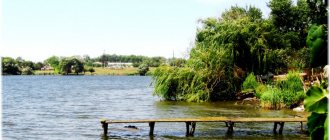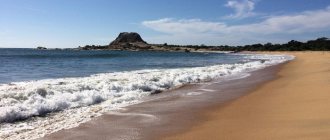Since Sochi is a relatively young city (urbanization processes in the Sochi region began only after 1864), the population of this city was formed mainly due to external migration. Sochi is one of the few Russian cities whose population has been growing steadily since the 1980s, thanks to the prestige of the resort, favorable climate and jobs. A slight decline in the total population was noted only after 2002, however, the population indicator within the city limits maintains an upward trend.
General information and history of Sochi
The city “stretched” from the resort village of Magri to the Psou River for almost one hundred and fifty kilometers.
One hundred and fifteen kilometers of this is a beach strip. One hundred and fifteen kilometers of never-freezing, alluring sea! It is no wonder that the first landowners here were members of the royal family. The tradition has stuck. Now government members, deputies, artists, and athletes can boast of real estate in Greater Sochi. Someday you and I can too. Maybe.
The well-known road from Adler airport
Not so long ago, a distinctive people lived on the territory of Sochi - the Adygs: Adygeans, Kabardians, Circassians. But the Crimean Khanate, the Ottoman Empire and Russia tirelessly competed for influence in the North Caucasus. As a result of the eighth Russian-Turkish war, the Treaty of Adrianople was signed in September 1829, transferring to Russia the rights to the Black Sea coast from the Kuban River to the pier of St. Nicholas. Nobody asked the Circassians for their consent to conclude the agreement.
Adygs
In 1864, after the end of the Caucasian War, the Circassians and Ubykhs were faced with a choice: either accept Russian citizenship and move to lands indicated by the tsarist government, or go to Turkey on Turkish ships. There was enough of both. More than 500 thousand people left their native lands. But there were also those who preferred death in the gorges to resettlement, saving the last bullet for the invaders. May 21, the day of the end of the Caucasian War, is considered in many Caucasian diasporas to be the “Day of Remembrance and Sorrow for the Victims of the Caucasian War.”
Well, let's not talk about sad things. At the same time, the settlement of the territory of present-day Sochi began. By the end of the 19th century, representatives of twenty-five nationalities were already living peacefully here: Russians, Ukrainians, Armenians, Circassians, Greeks...
Dynamics by year
The official statistical service Rosstat and the Unified Interdepartmental Information and Statistical System have published all the data regarding the growth dynamics of Sochi residents 2005-2020.
| Population of Sochi, thousand people. | Years. |
| 329 | 2002 |
| 328 | 2005 |
| 343 | 2011 |
| 360 | 2012 |
| 368 | 2013 |
| 399 | 2014 |
| 389 | 2015 |
| 401 | 2016 |
| 411 | 2017 |
| 424 | 2018 |
| 438 | 2019 |
| 443 | 2020 |
Thanks to the statistics presented, we are able to roughly estimate the rate of population growth in Sochi. The noticeable jump in 2015 corresponds to a well-known event: this year Russia received the status of host country for the 2018 FIFA World Cup. Over 3 years, the number of residents increased to 34,335 people - the maximum jump for the entire study period. Today the city's population is 443,562 people.
Ecology and climate of Sochi
In terms of its climatic conditions, Sochi is a unique city. The Main Caucasus Range protects the city from cold winds, and the Black Sea saturates it with warmth. Sochi residents are familiar with three seasons: late autumn here gives way to early spring, passing winter. Sochi is the only city in Russia where walking along the streets you can easily see palm trees and magnolias, tangerines and lemons, cypresses and boxwood. The world's northernmost tea is grown here.
Sochi nature. Photo by vorondoctor (https://fotki.yandex.ru/users/vorondoctor)
It is impossible not to admire the natural landscape of the city: wild rivers, mountain gorges, waterfalls and alpine lakes - all this is Sochi. Numerous websites and tourist guides will vying with each other and excitedly tell you that Sochi is the only place in Russia where, having experienced all the delights of skiing down the slopes of Krasnaya Polyana in the morning, you can swim in the warm Black Sea in the evening. It is possible if you are a fairly wealthy person. The Krasnaya Polyana ski resort is slowly but surely becoming the most expensive resort in Europe.
Krasnaya Polyana. Photo by inton baylish (https://fotki.yandex.ru/users/balyshev-shambala)
When talking about Sochi, it is impossible not to mention that the city was honored to host the XXII Winter Olympic Games. By the way, the Summer Olympic Games in Moscow were also the XXII.
Environmentalists immediately became opponents of the Winter Olympic Games in Sochi. Still would! Two thirds of the territory of Greater Sochi is occupied by the Sochi National Park. It borders the Caucasus Biosphere Reserve, included in the list of UNESCO World Natural Heritage sites. All this could cause enormous damage.
Let’s say right away that the worst predictions of environmentalists have come true. The construction of many Olympic facilities was carried out without a positive conclusion from an environmental assessment. The Imereti Lowland, the bed of the Mzymta River, and Krasnaya Polyana (Adler District) were especially affected.
Sochi. Clock counting down to the start of the Olympics. Photo by acropolisX (https://fotki.yandex.ru/users/acropolisx/)
Urbanization
The table shows the urban population of the microdistricts of Sochi proper. The municipal formation of the resort city of Sochi also includes an urban settlement and rural districts. The population of the municipality of the resort city of Sochi is 530,391 people. (2020), including:
Urban (within city limits: microdistricts) - 411.5 thousand people. (83.5%)
Gorodskoye (within the city limits and the urban-type settlement of Krasnaya Polyana) - 416.2 thousand people. (84.5%)
Rural (rural districts: villages, towns, auls) - 76.4 thousand people. (15.5%)
Dynamics of urban and rural population
84.56% of the population of the municipality live in urban areas (Sochi, Krasnaya Polyana).
Population of Sochi
According to the latest population estimates, 424,281 people permanently live in Sochi. The population increase, compared to the 2010 census, was almost fourfold. We readily believe this trend: who doesn’t want to live and work by the sea!
Every new season, a large number of seasonal workers from various regions of the Russian Federation flock to Sochi. They go to find work in the food and service sector for tourists. The luckiest of them stay here forever.
People of more than a hundred nationalities live in Sochi. Mainly Russians (more than 60 percent) and Armenians (more than 20 percent). The remaining twenty percent falls on everyone else: Ukrainians, Circassians, Belarusians, Tatars. Over the past ten years, the number of Dagestanis, Chechens, and Circassians in the city has increased. The percentage of Armenians among the population increased after the Spitak earthquake. People left homeless were resettled in health resorts that were empty in winter. The Georgian population increased after the Georgian-Abkhaz conflict in the early nineties. The number of Greeks, on the contrary, is declining. The end of the last century was marked by their mass departure to Greece.
We think you already understand what kind of “national cocktail” Sochi is. Meanwhile, by and large, the city is alien to interethnic conflicts.
Russian International Olympic University. Photo by ninon2410 (https://fotki.yandex.ru/users/ninon2410/)
Recently, the number of higher educational institutions in Russia has increased. Sochi does not lag behind the rest of the country. Several of its own universities have opened here, as well as branches of famous Moscow higher educational institutions. All this has led to a significant increase in the percentage of people with higher education in Sochi. We can only hope that the sharp increase in the number of educated people does not come at the expense of quality. But this applies not only to Sochi, but to the country as a whole.
International Innovation Institute in Sochi
Districts and real estate in Sochi
Officially, Sochi is divided into four districts: Adlersky, Khostinsky, Central and Lazarevsky. There is nothing complicated in their location - they stretch out one after another from Abkhazia to the village of Magri, along the seashore. But Adler should not be confused with the Adlersky district, Khosta with Khostinsky, and so on. This is especially important when purchasing real estate.
Scheme map of Sochi districts
The Adler region begins with the Imereti Lowland. Nizhne-Imeritinskaya Bay has long been famous for its beaches. Wide, half sandy, half pebble, undamaged by breakwaters and piers, they have always attracted vacationers. For many years this place was considered very quiet: Old Believers and workers of the Rossiya state farm lived here in private houses, but the main Olympic construction took place here. Hotels, a cargo port, a skating center, and the Small and Large ice arenas were built.
Adler Center
To resettle local residents whose houses fell into the Olympic construction zone, several microdistricts were built: Veseloye-Psou, Tavrichesky, Selo Nekrasovskoye. The Imeritinskaya Lowland itself has turned into a place where various sporting events are held on the basis of the built Olympic facilities. However, land prices here are very high, from approximately one to three million rubles per hundred square meters. Buyers are attracted by the proximity to the sea and Olympic venues.
Sign in Sochi
Krasnaya Polyana is the site of the 2014 Olympic Games. In 2000, Vladimir Putin amazed the residents of Krasnaya Polyana by skiing on the same slopes as ordinary people. Could anyone then imagine what the president’s love for skiing would result in!
Now Krasnaya Polyana is one of the most unique ski resorts in Russia. Clean air, mineral springs, fabulous landscapes, and most importantly, breathtaking vistas attract people here like a magnet.
Krasnaya Polyana. Rosa Khutor. Photo by nata-katerina (https://fotki.yandex.ru/users/nata-katerina/)
Investments in real estate in Krasnaya Polyana are currently considered almost the most promising in Russia. Enterprising people here quickly set up superbly equipped houses, the living space in which costs from 110 thousand rubles. per square meter. At the construction stage, prices are lower - 85 thousand rubles. for 1 m2.
We hope you do not get the impression that all real estate in the Adler region is located in close proximity to the Olympic venues.
To the left and right of the center of Adler there are two residential microdistricts - Blinovo and Golubye Dali, built up with typical five-story buildings and high-rise buildings. The areas are located approximately 3 km from the sea and therefore prices for apartments here are relatively low. Approximately 65 thousand rubles. per square meter of secondary housing. The relief of these areas leaves much to be desired. Sochi is located in such a way that everything that is not a plain on the seashore is already foothills or mountains. But residents of these areas do not have to spend money on fitness.
The center of Adler is a recreation area. There are old and new apartment buildings, private hotels, and a lot of luxury housing is being built here. Buying secondary housing here is extremely problematic; there are practically no advertisements for sale. Such housing costs from 80 thousand rubles. per square meter. Housing prices in finished luxury new buildings start from 90 thousand per 1 m2, and those under construction from 40 thousand per 1 m2.
On the seashore, between the Golubye Dali microdistrict and the Kudepsta River, lies the Chkalovsky microdistrict. The microdistrict is rightly considered the center of resort life in the Adler region. In the sanatorium-resort complex “Resort Town” located nearby, there is an oceanarium, a dolphinarium, and a water park. Local residents took advantage of this proximity and rebuilt the private sector into 2-5-story hotels, which during the season provide them with income for the whole year. A square meter of living space in such a hotel costs more than 100 thousand rubles.
Khostinsky district ranks second in terms of real estate value, after Central. This is explained simply: in addition to Kudepsta and the center of Khosta, it includes the area of the circus, the Arboretum park, and the Svetlana boarding house. All these areas are practically the center of Sochi. The land here is incredibly expensive - in close proximity to the sea, its cost can reach several million rubles per hundred square meters. And the cost of 1 m2 in business class houses reaches 150 thousand rubles.
Sochi Circus. Photo by ninon2410 (https://fotki.yandex.ru/users/ninon2410/)
But we were in a hurry. The Khostinsky district begins with the Kudepsta microdistrict, named after the river at the mouth of which it is located. “Kudepsta” translated from Adyghe means black, oily river. This is far from the most comfortable area of the city and real estate prices here are appropriate. Secondary housing starts from 65 thousand rubles. for 1 m2, housing in new buildings “turnkey” - from 60 thousand rubles. for 1 m2.
Khosta (center) also got its name from the name of the river. The peculiarity of this area is that it is protected on all sides by mountains, and the valley is exactly framed. They say that the temperature here is one degree higher than in the center of Sochi, but the humidity is much lower. It is in this area that the forest of the pre-glacial period grows - the protected Yew-boxwood grove. Centuries-old trees covered with moss stand majestically in the greenish twilight. And all this is practically within the city limits. The beaches here are covered with small pebbles and sand. The cost of secondary housing in Khosta is from 80 thousand rubles. per square meter.
Night Hosta
The longest district of the city (105 kilometers) is Lazarevsky. It includes several resort villages: Lazarevsky, Loo, Golovinka, Dagomys, Yakornaya Shchel and others. The private sector is widespread in the villages, and recently a large number of modernly equipped private hotels have appeared.
The largest of the villages is the village of Lazarevsky. Here, in addition to the private sector, there are standard five-story buildings and high-rise buildings are being built, albeit to a limited extent. They are usually located at higher elevations. One meter of secondary housing here costs from 50 thousand rubles, housing in a new turnkey building costs from 55 thousand rubles. To get from Lazarevskoye to the center of Sochi, you need to overcome 70 kilometers of serpentine road, which does not contribute to the high cost of housing. Of all four districts of Greater Sochi, this is the cheapest.
The most expensive housing in Sochi is in the Central District. This is where a huge number of luxury houses are built. Land by the sea is so expensive that it is unprofitable to build other housing here. Economy-class housing is being built further away, on Donskoy, Makarenko, and KSM streets.
In the ranking of the most expensive housing in Russia, Sochi alternates between second and third place, sometimes ahead of, sometimes behind, St. Petersburg. But this does not mean that it is impossible for the middle class to purchase real estate in Sochi. In addition to penthouses costing millions of dollars, there are, for example, studio apartments on the market. The cost per square meter of such an apartment starts from 25 thousand rubles.
It's no secret that, unlike Moscow and St. Petersburg, cottage construction in Sochi is just beginning to gain momentum. This is due to the fact that the majority of home buyers in Sochi are from other cities. But buying a cottage house in order to use it several days a year is an expensive pleasure. The second reason is the complex terrain of the building sites. There is practically no land left near the sea, and communication in the mountains is associated with certain difficulties.
But, despite all of the above, all four districts of Greater Sochi can boast of their business and elite class cottage villages. The most famous of them: “Orchid Park” in Adler, “Sea Penates” in Khost, “South Golitsino” in the Lazarevsky district, “Golden Sail” in Central Sochi. Prices in such villages are very scattered - from 8 to 120 million rubles for a cottage.
Private sector Sochi
But in general, everything is not so scary. Tireless statistics have calculated that on average one square meter of living space in Greater Sochi in 2012 cost: 73 thousand rubles. on the secondary market and 71 thousand rubles. in new buildings. The average cost of land was 735 thousand rubles. per hundred.
And further. Sochi is one of the cities where questions about the legality of construction arise everywhere. Don't be fooled!
Coat of arms
The coat of arms of Sochi is presented in the form of a French shield. It is divided into four parts: two silver and scarlet. On top of everything is azure shingles. It is encumbered at the top with a bowl without a stand. At the top it is accompanied by a thunder arrow to the belt, and at the bottom – with silver drops.
In the left corner of the shield there are three mountains bordered by azure. To the right is a golden palm tree. The yellow sun with rays is in the third quadrant. The fourth contains a thin, chipped-concave azure belt.
The artistic composition was approved by decision of the City Assembly No. 199 of June 7, 2005. Included in the State Heraldic Register of the Russian Federation under No. 1505.
City infrastructure
Greater Sochi is a city with a well-developed transport infrastructure. Each of its districts has a railway station, in the Central district there is a seaport, and in Adler district there is an airport. The main type of urban transport is minibuses. There are so many of them here that it seems that all the drivers of the former Soviet republics came to Sochi to earn extra money.
New railway station in Sochi. Photo by Under.sail (https://fotki.yandex.ru/users/under-sail/)
However, traffic jams became a problem for the city. You won’t surprise anyone here with the statement that you traveled from Adler to Sochi (20 kilometers) in three to four hours. Your interlocutor will just shrug. The fact is that many large enterprises, banks and educational institutions are located in the Central region, and people tend to get to work in the morning.
Traffic jams in Sochi
And yet, I would not like to take back my words about a well-developed transport infrastructure. In 2012, in some way unimaginable for the average person, disparate sections of roads, tunnels, bridges and overpasses under construction began to unite into a single whole. And it became clear to everyone that “...the city will be” and “...the garden will bloom.” How much this cost the country is another question. Everyone can already see: the first record of the Olympic Games in Sochi has already been set. These are the costs of carrying them out. By the way, against the backdrop of the new highways, the numerous side streets look even worse. The authorities are in no hurry to repair them.
Noise-absorbing walls of the new road. Photo by rina-simsim (https://fotki.yandex.ru/users/rina-simsim/)
The big problem of the city of Sochi has always been electricity supply. The capacity of existing thermal power plants was sorely lacking, and electricity supplies from Kuban were hampered by extreme weather conditions in the mountains and difficult terrain. With the start of Olympic construction and a sharp jump in electricity consumption, in connection with this, the situation worsened several times.
Currently, from time to time, entire areas of the city sit without electricity for several hours, or even days. The situation in villages is even worse. In addition to electricity, water pumping stations that provide water and boiler houses that provide heat are turned off there. The city authorities assure that the situation will be corrected by the commissioning of the Adler thermal power plant with a capacity of 360 MW, scheduled for May 2012. Well, wait and see. We saw that it was put into operation in 2013. Local residents say that the situation with power outages is no longer so bad.
Sochi. Seaport. Photo by nadia.pron (https://fotki.yandex.ru/users/nadia-pron/)
Once upon a time, one of the previous mayors of Sochi, in a public speech, had the imprudence to say that Sochi is a city for the rich. The people remembered this mistake and did not forgive it. Now it is gloatingly attributed to every new head of the city. Our people have historically considered Moscow to be the standard of living standard. Sochi residents are no exception. They like to say that in Sochi, compared to Moscow, prices for food and utilities are higher.
The average monthly salary in Sochi is at least two times lower than in Moscow. Although, recently, against the backdrop of a construction boom, companies have proliferated that are willing to pay their employees decent money for Sochi. As elsewhere, the most vulnerable class in the city are pensioners. Rumors that Sochi's old people are spitting on the ceiling when renting out extra living space are greatly exaggerated.
For a long time, kindergartens were not built in Sochi. Residents of the city, with difficulty, made do with children's institutions built before the collapse of the USSR. In recent years, the birth rate in Sochi has increased. A solution was found by building extensions to existing kindergartens. This did not solve the problem completely, but at least smoothed it out.
Even the most critical Sochi resident cannot fail to recognize the increasing pace of renewal of the city's social infrastructure. Over the past year, 6 libraries, 15 clinics, 32 schools have been renovated. 3 hospitals, 4 schools, 3 kindergartens were built.
Travel to the Black Sea
On the Black Sea coast of the Caucasus Mountains there are the most famous and popular resort towns among the population. Most of the year it is warm and sunny here, which is conducive to a relaxing holiday. The azure sea beckons and the snow-covered Caucasus delights. To all this we must also add clean air, the bright green of broad-leaved forests and the dark green of coniferous forests. In Sochi, in addition to resort advantages and healing opportunities, there are valuable natural monuments and cultural and historical attractions. A rich entertainment program is offered by the cinema and concert hall, theatre, and circus. You can visit the arboretum, oceanarium, water park, dolphinarium, explore the city museums, and visit the port.
Bus and walking excursions complement swimming and relaxing on the beach. There are conditions for playing sports and combining them with a cultural program. Thrill-seekers enjoy rafting down mountain rivers, diving, kitesurfing and yachting. Hiking trails lead to the Bolshoy Akhun recreational area. Here are the cascades of the Agur waterfall, an observation tower at an altitude of 630 m. You can visit the sculpture of Prometheus breaking the chains. Legends say that the gods punished him for helping people. According to ancient legends, on the western slopes of the Caucasus is the very rock to which Prometheus was chained. The city of Sochi in southwestern Russia attracts numerous visitors throughout the year. There are ample opportunities for the development of beach, excursion, family, cruise, sports and other types of tourism. The bright and hospitable city is reminiscent of a caring Prometheus, who gave people his love.
Enterprises and work in Sochi
In time immemorial, when there was nowhere for an apple to fall on the city’s beaches, Greater Sochi received 5 million vacationers a year. Well, the authorities know better, although this figure seems somewhat inflated. But that's not what this is about. All of these, even if a little less, people need to be accepted, housed, and fed.
Sochi beach
We think it’s already clear why Sochi has the lowest unemployment rate in the Krasnodar Territory. The basic sectors of the city's economy are: tourism, healthcare, trade and catering. The city needs a whole army of seasonal workers: waiters and photographers, drivers and fitness trainers. There are more than two hundred boarding houses, sanatoriums, hotels and tourist centers in the city. But this is not without problems. In winter, service personnel of many health resorts are sent on forced, partially paid or unpaid leave.
New hotels
Public catering in Sochi, in addition to traditional establishments, is represented by a large number of pizzerias, sushi bars, Baskin Robbins ice cream parlors, beer restaurants, and fast food chains: McDonald's, RICE, Subway, KFC.
Private brewery on the waterfront
We should not forget that all these establishments require not only cooks, bartenders, waiters, but also administrators, animators, office managers, hostesses, and sometimes managers.
Nowadays, even the smallest company is equipped with computer technology. Therefore, in Sochi, as elsewhere, IT specialists are in demand. The same can be said about specialists in the field of outdoor advertising, landscape designers, and foreign language teachers.
An enterprise of regional importance is the Sochi Meat Processing Plant. The plant is widely known outside of Sochi. It supplies its products to 85 cities in Russia. The company employs one and a half thousand people. Another thousand two hundred people are employed at one of the largest producers of bakery products in the region - Sochi Bread Factory OJSC. These enterprises, one might say, were lucky.
Sochi meat processing plant
When the privatization of food industry enterprises was allowed, the following were destroyed in the city: a fish processing plant, a dairy plant, and a confectionery factory. The production volume of the Adler poultry farm, the largest in the Krasnodar region, has decreased significantly. The Adler tea factory was demolished. All this does not contribute to increasing the number of jobs. One can only guess who benefits from all this.
The Adler Tea Factory stood on this site.
The huge influx of vacationers contributes to the development of the banking sector. We will not list all the banking institutions in Sochi, there are too many of them, let’s just say that these are mainly branches of large Krasnodar and Moscow banks. The salaries of bank employees, contrary to popular belief, are low, and the work schedule is complex.
Large-scale construction has led to an increase in the number of construction companies. And each of them requires an accountant. Some construction companies are willing to pay their accountants quite a decent amount of money. The main thing here is not to get a job in a fly-by-night company.
Thanks to the construction of Olympic facilities, Sochi became a city where a whole army of skilled workers was required: electrical installers, monolithic workers, reinforcement workers, concrete carpenters, formwork workers, and electric and gas welders. Unlike general workers, they received high salaries, and when working on a rotational basis, they received housing and food. Moreover, not only blue-collar jobs were in demand. The construction site needs geologists, architects, engineers of water supply and sewerage networks, heating and ventilation systems, and energy. Salaries at Olympic venues were much higher than the average salary in the city. The children of such specialists are provided with places in kindergartens and schools, and they are paid to live in rented apartments.
In general, let’s say right away that working in Sochi is difficult. When you look at the people crowding the beaches, bowling alleys, and restaurants, it’s hard to believe that they all worked for a whole year in order to spend the money they earned in a few days. The situation in the city, especially in the summer (read six months of the year), is perceived as a never-ending holiday. And not everyone is ready to work on holidays.
Post-revolutionary heyday
When the revolution occurred, the new Soviet government did not abandon the Black Sea city.
True, we had to go through difficult times during the Civil War. As throughout Russia, military operations took place in the Black Sea region.
Moreover, historically it turned out that the fratricidal massacre ended in Sochi. At one of the city dachas, on May 2, 1920, the parties signed an act of unconditional surrender of Anton Denikin’s army of 60 thousand people. The military leader himself, the commander of the White Guards, left Russia forever from the port of Novorossiysk even before the signing of the act.
The period after the civil war became a new era of development for Sochi:
- In the 1920s, the only bison reserve in the young state was founded. Today it is called the Caucasian State Biosphere Reserve named after Kh. G. Shaposhnikov.
- The railway station was completed, and the areas damaged during the hostilities were completely restored by the authorities.
- In the 30s, Sochi became a huge construction site. The city was undergoing reconstruction of local infrastructure, roads were built, and new sanatoriums were opened.
- The famous funicular, which connects the buildings of the Sochinsky sanatorium, was also built in 1932-1934.
Post-revolutionary period.
Crime
Sochi authorities constantly report a decrease in crime in the city. But judge for yourself whether this can be. The city employs a large number of unskilled workers between the ages of twenty and forty. Some of them have a criminal past, which employers have little interest in. Many of those who came to work on the construction of Olympic facilities expected exorbitant wages. We don’t argue that in some places construction sites pay good money, but only to skilled workers and engineering and technical personnel.
What do you order the builders to do when wages were delayed at the Olympic venues? People who came to Sochi to improve their family’s well-being do not even have enough money to return home. Some people go on strike to seek the truth, others commit crimes. We are not making excuses, we are stating a well-known fact: along with the Olympic construction, the number of crimes in Sochi has only increased. This is especially true for crimes related to encroachment on the property of citizens.
Fisht Stadium. Photo by natalia (https://fotki.yandex.ru/users/nnp1603/)
The installation of CCTV cameras provided for by the Safe City program did not produce much results. Every second crime in the city is not solved. But one such camera, including maintenance, costs about three hundred thousand rubles.
They say that the cream of the Olympic pie was shared not only by the government, but also by the criminal world. Who knows, maybe that’s why the number of crimes involving firearms has increased in Sochi. But we were much more shocked by another crime.
On the night of August 6, 2010, in the Golubye Dali microdistrict of the Adler region, a 70-year-old old woman and her 17-year-old grandson were brutally murdered. After the crime was committed, the apartment was set on fire. A minor student, Ilya Orlov, and his grandmother received several stabbing wounds, the pensioner’s hands were tied behind her back. It turned out that the old woman had witnessed a crime. Moreover, having seen how the girl was being raped, the woman began to shout that she remembered the criminals. For which she paid with her life, and not only her own. It turns out that in order to protect your loved ones, you need to remain silent more... The conclusions are not encouraging.
